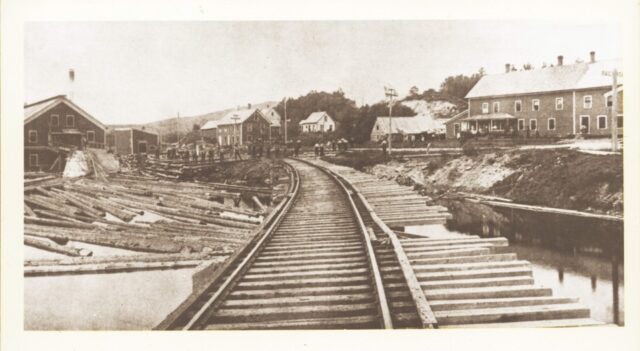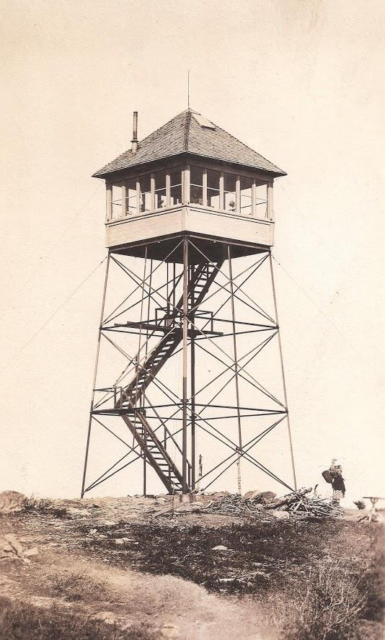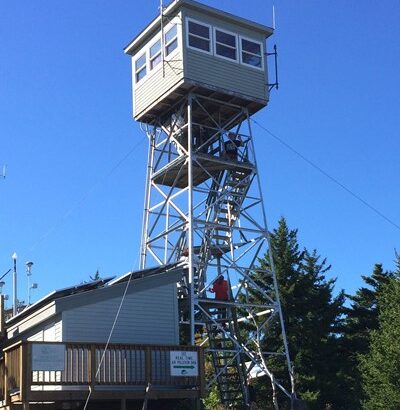Rebecca Durinick, SCA Interpretive Ranger
Fire towers have been longstanding landmarks among the New Hampshire mountain skyline. For over a hundred years many of these towers have provided essential fire prevention. Over time their usefulness has declined, but the still existing towers are used to this day. All of the fire towers have spectacular views of the surrounding landscape and are worth the visit. This is especially true if you plan to complete the fire tower quest.

Forestry Fuels Fires
For a long time, New Hampshire was mostly family hill farms. Competition with the Mid-West and demand for timber brought an end to the widespread farming. It wasn’t until the 1800s that the state turned to commercial logging. By the 1880s and the early 1900s, New Hampshire had a booming lumber industry.
Loggers would clear-cut forests. The logs were pulled by horses and oxen to the river and “driven” down the river to Mills. Logging towns emerged around mills. Berlin and Groveton were two prominent mills. The Berlin Mill is still running today. As the demand for wood products grew the machinery saw many improvements. This included wood-burning locomotives that were used to haul timber. The logging debris left behind combined with the sparks from locomotives increased the number of wildfires. Forest fire prevention and detection then became a necessity.

Fire Prevention and the First Towers
Due to the increase in fires, watchful eyes were needed to be kept on the surrounding area. This meant fire towers needed to be above the rest of the landscape. Mountains are some of the best places to naturally provide elevation, so that is where we find them today. The additional tower height provides an even better viewpoint.
During the late 1800s fire towers started to see use in the US to keep a lookout for active wildfires. In around 1903 the first tower was built in Croydon, NH. This would be the first of many to come into action. At this time the lookout might signal a forest fire by heliograph, carrier pigeon, or phone. By 1912 there were 12 state fire towers across New Hampshire. In the 1920s the state improved many of the structures to be metal instead of wood to make them more lightning resistant and durable.
The public soon caught on that many of these fire towers provide a great view. In the 1930s they decided to upgrade the towers from ladders to stairs to make access easier for visitors. This led to the additional purpose to the fire towers as an educational tool. At its peak there were over 80 fire towers across the state public and private.
Falling Out of Use
World War II left many fire towers unmanned. Some of the look out positions were taken up by women called Women Observers on the Forest (WOOFs). As the logging industry changed the need for the watch decreased. Airplanes after WWII were also able to fly over and making it unnecessary for full-time staffing at fire towers. Many of the fire towers were shut down in the 1980s and 90s.

Fire Towers Today
Today only fifteen of the public fire towers remain. Many of the fire towers are only manned when conditions could warrant a wildfire. This is mainly in the Spring before the leaves have bud on the trees. The lookouts will man the cabs on top of the fire towers. Fire towers have also moved towards a recreational and educational purpose. New Hampshire even promotes their visitation. All the lookouts are accessible to the public. Sometimes they are closed for maintenance and repair. So, check ahead of time if you really want to go up. Currently the Weeks tower on Mt. Prospect is closed for repair (2023). Generally, the cabs are off limits to the public.
New Hampshire Fire Tower Quest
The New Hampshire Fire Tower Quest is one way to experience the wonderful wilderness of New Hampshire. The N.H. Division of Forests & Lands will give you a patch and a sticker for visiting 5 towers. Just send in the completed brochure check list linked below. There isn’t a time limit so don’t feel rushed to get all 5 done in a day. Three towers have motor vehicle access when the auto road is open Mt. Prospect, Milan Hill, and Pack Monadnock. I have been to Mt. Prospect and Millan Hill myself and can say it is certainly worth a visit. In September and October I will be at Pack Monadnock. Come drop by and say hi on your way to complete your quest!
https://www.nh.gov/nhdfl/documents/tower-request-brochure.pdf
References
N.H. Division of Forests & Lands. (2023, April). NH Forest Facts NH fire tower quest program – nh.gov. https://www.nh.gov/nhdfl/documents/tower-request-brochure.pdf
NH Division of Forests and Lands. (2021). Fire tower history: Natural heritage. Fire Tower History | Natural Heritage . https://www.nh.gov/nhdfl/natural-heritage/fire-towers/fire-tower-history.htm
NH PBS. (2002). Logging in New Hampshire. Our New Hampshire – our renewable resource. http://www.nhptv.org/kn/itv/ournh/ournhtg13.htm

